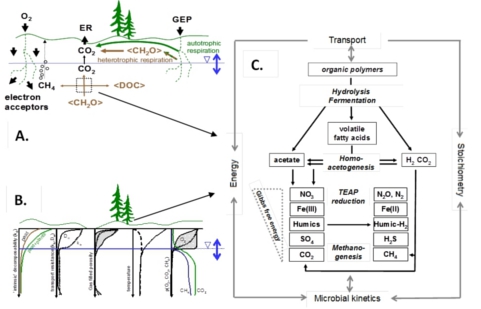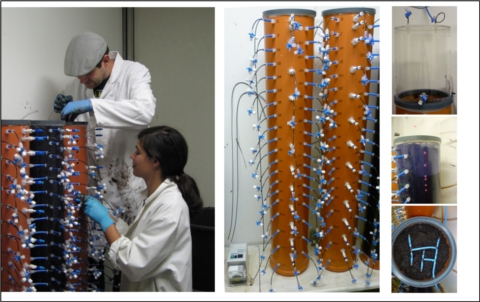ETRACA
Does energy, water and gas transport determine carbon sequestration and methane release in anoxic peatland soils? - Testing a novel hypothesis.

Schematic of (A) small-scale biogeochemical processes, (B) distribution of controls involved in belowground carbon cycling in wetlands, (C) the regulation and impact of exo-enzymatic activity on anaerobic decomposition. Abbreviations not explained in text: ER = Ecosystem Respiration, GEP = Gross Ecosystem Production, CH2O = organic matter, kd = decomposition, kh = hydraulic conductivity, Dw = Diffusion). Major uncertainty lies in the spatiotemporal variability of the controls and – as addressed in this proposal – in the interaction between water and gas transport, Gibbs free energy, microbial kinetics. Background
Northern peatlands cover about 450 million ha of land worldwide (Kivinen and Pakarinen, 1981), have functioned as sinks for C since the end of the last glaciation with average sequestration rates of 20-30 g C m-2 yr-1, and currently store between 250 and 500 Gt of C (Gorham, 1991). Peatlands are also sources of methane (CH4), contributing 4-10 % to the atmospheric CH4 burden (Mikaloff Fletcher et al., 2004), and sources of dissolved organic matter to surface waters (Urban et al., 1989). The role of peatlands in the global C cycle and their abundance in regions that are anticipated to undergo significant hydrologic change over the next decades has generated a considerable interest in their C budgets, mechanisms of C sequestration, and the controls on C exchange with the atmosphere and discharging waters. It has become consensus that the large and potentially vulnerable C pool close to the atmosphere could provide a major feedback on climate change if destabilized, or if the current partitioning in emission of CO2 and CH4 is substantially altered (Limpens et al., 2008). Such judgment has been supported by evidence that peatland development in the Holocene played a role for both atmospheric CO2 and CH4 composition and the climate system during this period (Yu, 2011).
The long-term fate of carbon in these environments under changed hydrologic conditions is thus of considerable scientific interest. Our knowledge of peatland carbon cycling is deficient with respect to the effects of energy-, water-, and gas transport that may ultimately control carbon sequestration and methane release. Carbon sequestration in the most widespread class of northern peatlands, ombrotrophic bogs, is supported by the burial of recalcitrant moss and shrub litter into a cold, water saturated, oxygen poor, and acidic environment that extends almost to the peatland surface (Clymo, 1984; Gorham, 1991). When organic material is buried in the water saturated zone, its decomposition strongly slows down, as various estimates have shown (Clymo, 1984; Belyea and Baird, 2006; Beer and Blodau, 2007). This ‘inactivation’ of peat is probably assisted by kinetic, thermodynamic, and stoichiometric constraints that have recently been described, for example by this research group. In the project we address this research gap using peat soil model systems in which geochemical conditions, water and gas transport can be controlled and the effects on key processes in anaerobic peat decomposition and methane release be quantified.Preliminary work has confirmed that lack of water transport can lead to an inactivation of methanogenesis and anaerobic decomposition of organic matter. The systematic examination of the effect water and gas transport rates and the causal interpretation is lacking to date. It is thus the overall objective of this project to elucidate these relationships.
Specifically, the project will analyze- how accumulation of carbon dioxide and methane in peats diminishes methane release and anaerobicrespiration and whether such effects can be attributed to a lack of free energy,
- how such product inhibition is controlled by geochemical and physical factors, such as temperature, soil acidity and chemical quality of the peat,
- how enzymatic activity responds to accumulation of carbon dioxide and methane, and geochemical and physical factors,
- how and to what extent rates of solute transport and ebullition control methanogenic decomposition in peats,
- if residence time of water in peats can be used to predict rates of anaerobic peat decomposition in peatlands.
Apart from closing an important knowledge gap, the project provides process-level data for the improvement of ecosystem models that aim at understanding and predicting the response of peatland carbon cycling to changing hydrologic conditions. Progress in this direction will allow for a more accurate analysis of climate change impacts on this important type of ecosystem in future studies.
References
- Beer, J., Blodau, C., 2007. Transport and thermodynamics constrain belowground carbon turnover in a northern peatland. Geochimica et Cosmochimica Acta 71, 2989-3002.
- Belyea, L.R., Baird, A.J., 2006. Beyond "The limits to peat bog growth'': Cross-scale feedback in peatland development. Ecological Monographs 76, 299-322.
- Clymo, R.S., 1984. The limits to peat bog growth. Phil. Trans. R. Soc. London B 303, 605-654.
- Gorham, E., 1991. Northern Peatlands: Role in the carbon cycle and probable responses to climatic warming. Ecological Applications 1, 182-195.
- Kivinen, E., Pakarinen, P., 1981. Geographical distribution of peat resources and major peatland complex types in the world. Ann. Acad. Sci. Fenn. Ser. A. 32, 1-28.
- Limpens, J., Berendse, F., Blodau, C., Canadell, J.G., Freeman, C., Holden, J., Roelet, N.T., Rydin, H., Schaepman-Strub, G., 2008. Peatlands and the carbon cycle: from local processes to global implications- a synthesis. Biogeosciences 5, 1475-1491.
- Mikaloff Fletcher, S.E., Tans, P.P., Bruhwiler, L.M., Miller, J.B., Heimann, M., 2004. CH4 sources estimated from atmospheric observations of CH4 and its C-13/C-12 isotopic ratios: 1. Inverse modeling of source processes. Global Biogeochemical Cycles 18, GB4004, doi:10.10292004GB002223.
- Urban, N.R., Bayley, S.E., Eisenreich, S.J., 1989. Export of dissolved organic carbon and acidity from peatlands. Water Resources Research 25, 1619-1628.
- Yu, Z., 2011. Holocene carbon flux histories of the world's peatlands: Global carbon cycle implications. The Holocene 21, 761-774.

Design of column experiments. M.Sc. student Frederic Bock and research assistant Ins Spangenberg are also displayed. Methods
The project uses laboratory model systems of differing complexity to analyze the decomposition of organic matter, in particular peat column and mesocosms, as well as incubation of smaller soil volumes. This way hydrologic and concentration conditions can be controlled and manipulated and mass balances and production rates of the examined peats be determined. To isolate effects of hydrological and geochemical factors, transport rates of solutes are varied in column experiments by adjusting water flow with peristaltic pumps and by facilitating gas transport. Also the presence and absence of oxygen is varied at the peat-atmosphere boundary (see pictures).
On the analytical side a multitude of methods is employed. These methods are only mentioned in a cursory way. One focus of the work is the quantification of carbon dioxide and methane production and fluxes using concentration measurements and chamber measurements. Soil gas concentrations are determined using gas samplers and gaschromatography. Non-invasive optical techniques are used to determine oxygen profiles in column and incubation experiments. We further attempt to study the evolution of gas bubbles in peat using the FDR (Function Domain Reflectory, ECH2O EC-5, Decagon Devices) technique. Changes in the in the balance between anaerobic respiration, methane formation and methane oxidation are studied using 13C-analyses in C02, CH4 and dissolved organic carbon (DOC), concentration profiles in the soil, and the isotopic composition of the emitted gas. To these ends we employ a CRDS analyzer (PICARRO, G2201-i.) coupled to a TOC analyzer. The bioenergetics of the terminal electron accepting processes is studied by the quantification of molecular hydrogen at trace gas levels (Ametek Trace Analytical TA 3000R), and by the analysis of fermentation products using ion chromatography (Metrohm). Incubation approaches are studied to link production rates of individual processes to bioenergetic conditions. As an auxiliary tool we use infrared and fluorescence spectroscopy to obtain background information about the chemical nature of the peats that are investigated.Thesis research
In 2013 one M.Sc. project (Frederick Bock) was conducted with the objective to test the experimental column system and obtain preliminary information about the influence of advection rates and gas transport and oxygen on organic matter decomposition.
In 2014 and 2015 we further provide the opportunity to carry out undergraduate and graduate student thesis work. Possible fields of investigation are:- Controls on the decomposition of peats by accumulation of decomposition products and geochemical conditions, such as oxygen concentrations and pH. In such work incubation approaches with microcosms will be used.
- Controls on enzyme activity in peats as a function of geochemical conditions. In such work incubation approaches with microcosms will be used as well.
- Application and further development of a simulation model to study the anaerobic decomposition of organic matter in peatlands. Such work will rely on the simulation tool STELLA.
If interested –also with regard to research assistantships – contact Prof. Dr. Christian Blodau or Simona Bonaiuti.Info
Project contact
University of Muenster
Institute of Landscape Ecology, Hydrology GroupPrincipal Investigator: Prof. Dr. Christian Blodau
Research associate: Simona Bonaiuti
Funding
German Science Foundation (DFG)
Project period: 10/2013 – 09/2016News and events
Instrumentation: In 2013 preliminary studies with column experiments were conducted.


